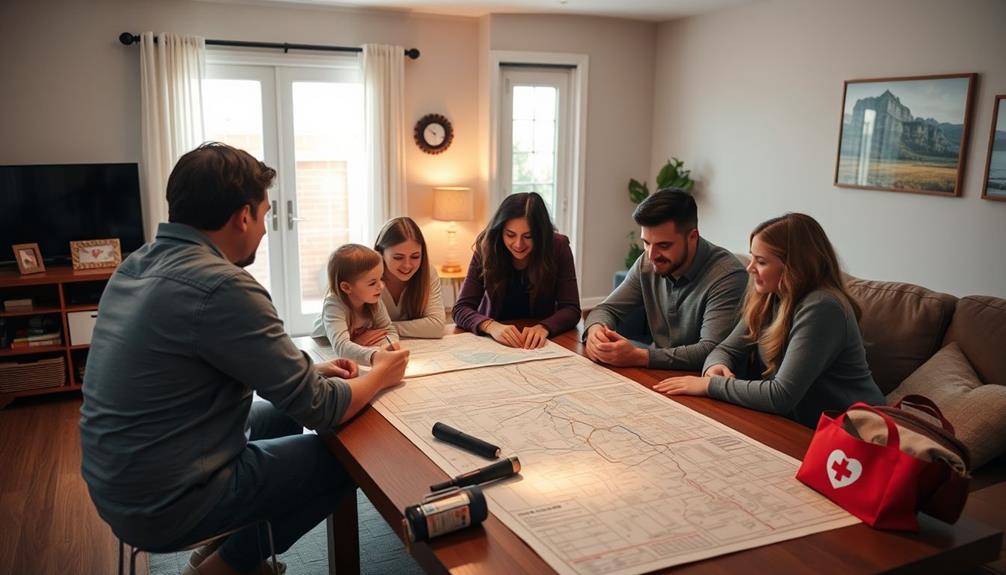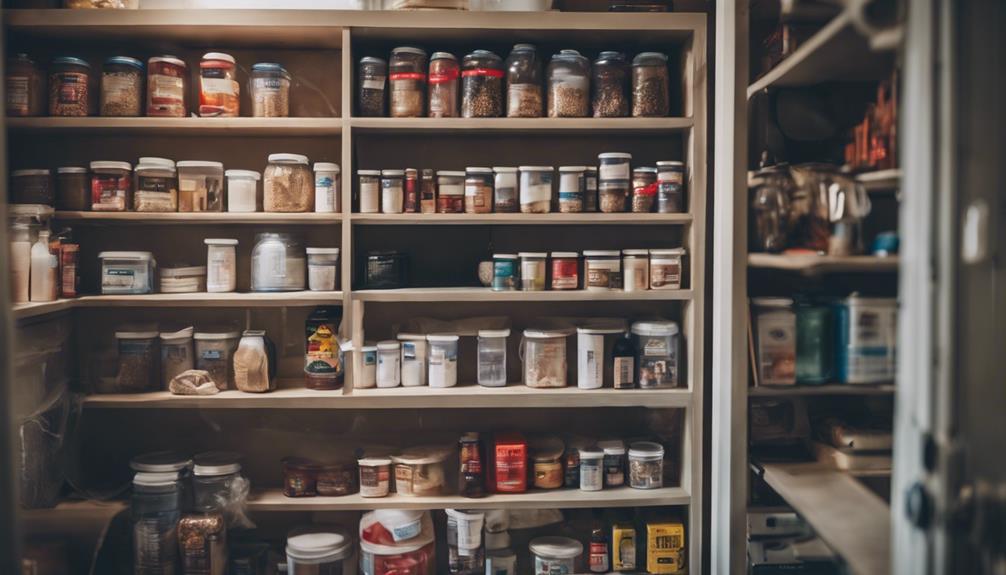Mastering your emergency plan means being prepared and reducing panic when it matters most. First, identify potential local emergencies and assign roles to family members to streamline responses. Designate meeting places, both nearby and further away, to reunite safely. Assemble an emergency kit stocked with essential items like water, food, and first aid supplies. Regularly practice your plan with all family members to build confidence. Finally, review your plan every six months and update it as needed. If you're ready to enhance your preparedness even further, there's more valuable information waiting for you.
Key Takeaways
- Assess potential local emergencies to understand risks and prepare accordingly.
- Designate meeting places for quick family reunification during crises.
- Assemble a tailored emergency kit with essential items for your household.
- Schedule biannual drills to practice your emergency procedures and enhance readiness.
- Regularly review and update your emergency plan based on feedback and changing circumstances.
Understanding Emergency Planning

When it comes to understanding emergency planning, you'll find that being prepared can make all the difference during a crisis. A well-thought-out plan reduces panic and confusion, allowing you to respond effectively. Knowing potential local emergencies enhances your readiness and guarantees you can act swiftly.
Designating familiar meeting places means your family can reunite quickly, minimizing stress. Think about alternative communication strategies, as traditional methods might fail during disasters. Tailoring your plan to fit your household's unique needs boosts its effectiveness.
Regular practice empowers everyone, assuring confidence when it matters most. Remember, proactive preparation before a disaster strikes is crucial. Your commitment to understanding emergency planning lays the groundwork for survival, safety, and resilience when challenges arise. By mastering situational awareness essentials, individuals can better anticipate potential risks and respond effectively under pressure. This heightened awareness, combined with consistent preparation, fosters quick decision-making and adaptability in critical moments. Ultimately, the combination of knowledge, practice, and vigilance becomes the key to navigating even the most unforeseen circumstances with confidence.
Steps for Creating Your Plan

Creating an effective emergency plan starts with understanding your unique risks and needs.
Begin by evaluating local emergencies that could impact you, like floods or fires. Collaborate with your family to define roles and responsibilities during a crisis. Designate specific meeting places both near home and outside your neighborhood to guarantee everyone knows where to regroup.
Document essential emergency contacts, including medical information, and prepare a clear communication strategy.
Next, gather essential supplies for an emergency kit, making sure it meets your household's needs. Don't forget to take advantage of discounts during National Preparedness Month to stock up on necessary items.
Practicing Your Emergency Plan

Regularly practicing your emergency plan is essential for ensuring everyone knows what to do during a crisis. By holding drills, you can reduce panic and reinforce knowledge.
Here's how to effectively practice your plan:
- Schedule drills biannually to maintain familiarity with procedures.
- Involve everyone, especially children, to help them understand their roles.
- Review the outcomes after each drill to evaluate effectiveness and gather feedback.
- Adjust your plan based on the feedback and any new circumstances.
Communicate any changes immediately to keep everyone informed.
Essential Emergency Kit Items

Having a well-stocked emergency kit is essential for your family's safety and preparedness during unforeseen events. To help you assemble your kit, here's a quick list of essential items to include:
| Item | Purpose |
|---|---|
| Water (1 gallon/person/day) | Hydration for at least 72 hours |
| Non-perishable food | Sustenance for you and your family |
| First aid supplies | Basic medical care in emergencies |
| Flashlight and batteries | Light source during power outages |
| Important documents | Identification and essential info |
Ensure you tailor your kit to your family's specific needs, including medications and any special supplies. Regularly check your kit and replace expired items to stay prepared!
Considerations for Special Needs

When planning for emergencies, it's crucial to evaluate the unique needs of each family member, especially those with special requirements.
Here are some key considerations to guarantee everyone's safety:
- Medical Supplies: Stock extra medications and medical devices, making sure they're easily accessible.
- Communication Tools: Use devices or apps that cater to specific communication needs, like hearing aids or speech devices.
- Evacuation Plans: Identify wheelchair-accessible routes and transportation options for individuals with mobility challenges.
- Emergency Contacts: Maintain an updated list of healthcare providers and emergency contacts, including any special instructions.
Reviewing and Updating Your Plan

After considering the unique needs of family members, it's time to focus on keeping your emergency plan relevant and effective.
Set a review schedule, ideally every six months, to guarantee everything is up-to-date. Use checklists to confirm evacuation routes, contact information, and supplies are current.
Gather feedback from family members after each drill, and make necessary adjustments based on their insights. Involve everyone in the review process to encourage accountability and guarantee all voices are heard.
Don't forget to leverage technology for reminders about upcoming reviews and to track drill outcomes.
Regular updates not only strengthen your plan but also boost your family's confidence in handling emergencies when they arise.
Building Community Preparedness

Building community preparedness is essential for enhancing collective safety during emergencies. By working together, you can strengthen your neighborhood's resilience.
Here are four steps to build community preparedness:
- Organize local meetings to discuss emergency plans and share resources.
- Create a neighborhood contact list that includes essential information for each household.
- Plan training sessions for skills like first aid and disaster response, ensuring everyone knows what to do.
- Develop a shared emergency kit that includes supplies for the community, providing a safety net when needed.
Frequently Asked Questions
How Can I Involve Children in Emergency Planning Effectively?
To involve children in emergency planning, explain the plan in simple terms, assign them specific roles, practice drills together, and encourage questions. Their participation boosts confidence and helps them understand the importance of preparedness.
What Should I Do if My Family Members Have Different Schedules?
If your family members have different schedules, coordinate discussions about the emergency plan during shared times. Use group texts or shared calendars to keep everyone informed, ensuring everyone knows their roles and responsibilities when emergencies arise.
How Can I Ensure My Elderly Relatives Are Prepared?
To guarantee your elderly relatives are prepared, discuss their specific needs, create a simple emergency plan together, practice regularly, and provide them with essential supplies. Regular check-ins can also help maintain their readiness and confidence.
What Are the Best Ways to Store My Emergency Kit?
Did you know 60% of households lack an emergency kit? To store yours effectively, use waterproof containers, keep it accessible, and regularly check supplies, ensuring everything's in order for quick access when needed.
How Can Local Businesses Contribute to Community Preparedness Efforts?
Local businesses can support community preparedness by hosting training workshops, donating supplies, offering discounts on emergency kits, and collaborating with organizations to provide resources. Engaging in these efforts strengthens community resilience and fosters a culture of readiness.
Conclusion
Just like a seasoned sailor navigates through stormy seas, you too can steer your family toward safety with a well-crafted emergency plan. By understanding your unique risks, practicing your responses, and having the right tools at hand, you're setting your ship on a steady course. Don't let uncertainty anchor you down; instead, keep your sails taut and your crew engaged. With these simple steps, you'll be ready to weather any storm that comes your way.










